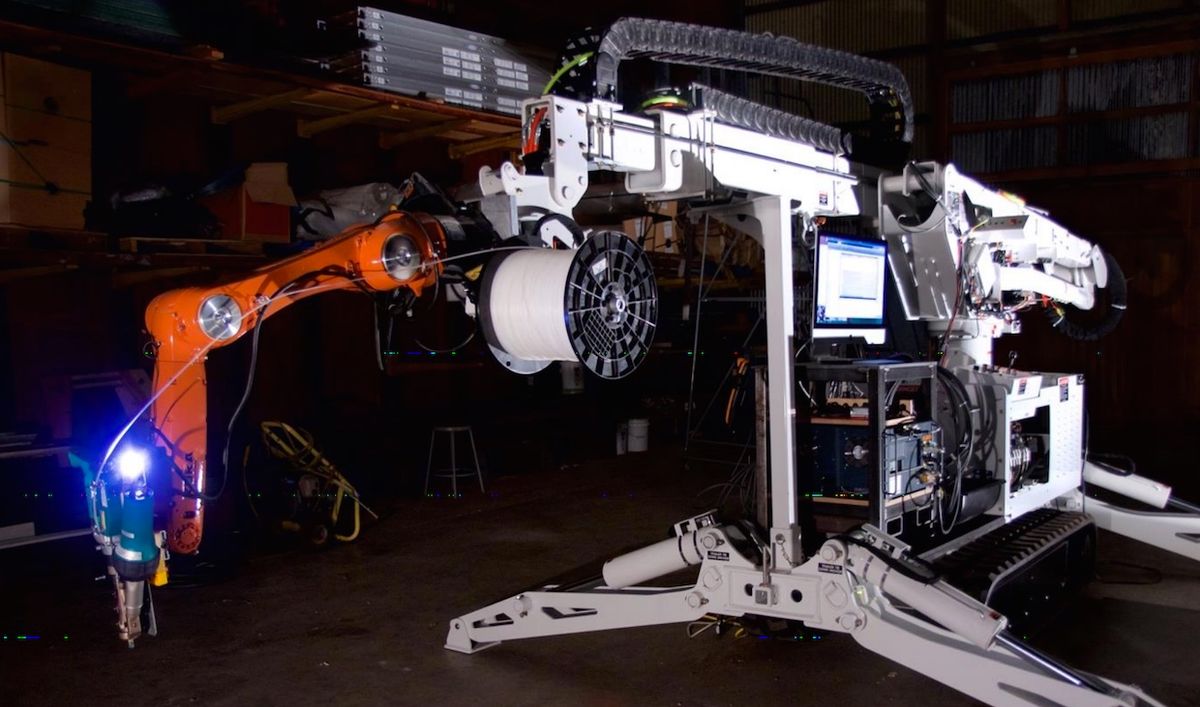Construction seems like an industry that, were I still living in Silicon Valley, I would be tempted to call “ripe for disruption.” Researchers at the MIT Media Lab agree, pointing out in a paper just published in Science Robotics that construction “relies on traditional fabrication technologies that are dangerous, slow, and energy-intensive.” Hey, sounds like a job for some robots, right?
The Media Lab’s paper introduces the Digital Construction Platform (DCP), which is “an automated construction system capable of customized on-site fabrication of architectural-scale structures.” In other words, it’s a robot arm that uses additive construction techniques to build large structures safely, quickly, and even (in some cases) renewably.

Some of the most interesting robots we’ve seen over recent years have used additive manufacturing to build small-scale structures, or even build themselves. Large-scale robotic construction has also been an area of active research, but none of the concepts or prototypes have really panned out. There have been bricklaying robots, gantry robots that can 3D-print buildings out of concrete, and even drones that build walls by transporting one brick at a time. The most practical of these solutions are probably the gantry-based 3D printers, but the big disadvantage of them is that they work best if you set them up somewhere and let them churn out prefabricated buildings.

MIT Media Lab’s Digital Construction Platform (DCP), on the other hand, is mobile (with a top speed of 0.5 meters per second) and self-contained. It’s battery powered (with a few solar panels on it and an option for more to be attached), so it can potentially run forever, or as long as you have sun. Otherwise, the DCP mimics much of the functionality of a 3D building printer: It has a long reach, giving it a maximum printable volume of 2,786 cubic meters. The robot itself is made out of two arms, modeled loosely on a human: There’s a big long arm with 4 degrees of freedom (DoF) that does all the gross motions, and one small, dexterous 6-DoF Kuka arm that takes care of fine motions like our hands and fingers would. Put it all together, and the total system cost comes to US $244,500, which is really not that bad.
The construction technique that the DCP uses is straightforward: There’s a sprayer at the end of the small arm that combines two chemicals into a liquid polyurethane foam that rapidly expands and hardens. You can program the DCP to print anything you like, but in the demo in the video above it’s whipping up a 14.6-meter-wide, 3.7-meter-tall hemispherical open dome at a rate of 1.728 cubic meters per hour, printing layer on top of layer. Rather than build the entire structure out of foam, the DCP is actually creating a concrete formwork: Two foam walls, one nested inside the other, with a space in the middle that you can pour concrete into to make a more permanent and resilient structure (or backfill it with dirt or anything else in a pinch), after dropping in plumbing and electrical and stuff. Leaving the foam in place after you do this just adds to the insulation of the resulting building. But even as-is, with just foam and no concrete, the structure is still strong enough for a well-fed grad student to play hopscotch on top of it:

Because the foam dries so quickly, it really is possible to make a dome out of it, since successive layers don't have to be directly on top of each other. They can even be offset by 90 degrees, enabling flat roofs or unsupported shelves and benches. When additional support is required, the researchers have been experimenting with autonomously embedding rebar, and also with chains that have been autonomously welded into rigid shapes, as shown in the concept below:

In order to be able to build on-demand structures anywhere, the DCP needs two things: power and materials. Power is a hassle, but there’s no real technological barrier, since (hypothetically) you can just add as many solar panels and batteries as necessary to keep the robot powered up and running. Building materials are a bit more of a challenge, because you can’t easily make spray foam ingredients from scratch. Fortunately, spray foam isn’t the only useful building material, even if it might be the most optimal one for these purposes. The researchers have also successfully done some preliminary experimentation with electro-sintered powdered glass, thermally deposited ice, and compressed earth containing gravel and hay fibers. Depending on where you want to build stuff, all of these materials are potentially available locally and in bulk.

This is a very compelling idea—as long as you supply sun and raw materials, these robots could built structures quickly, autonomously, and at very low cost, which are not three characteristics that you usually find together. The researchers have imagined several scenarios, including fabricating ice structures in polar environments and creating fractal structures out of sand in deserts to be later immersed in the ocean to provide coral reef habitat.

At this point, it seems as though robots like these would be most valuable after natural disasters or during refugee crises, when you need to be able to create an enormous amount of housing in low infrastructure areas very quickly and cheaply. Whether or not such robots will prove to be more practical than other solutions for rapid construction in the near term remains to be seen; as with many robotics applications, humans are still the cheapest and most efficient way to do things.
“Toward Site-Specific and Self-Sufficient Robotic Fabrication on Architectural Scales,” by Steven J. Keating, Julian C. Leland, Levi Cai, and Neri Oxman from the MIT Media Lab, was published in Science Robotics.
[ Science Robotics ]
Evan Ackerman is a senior editor at IEEE Spectrum. Since 2007, he has written over 6,000 articles on robotics and technology. He has a degree in Martian geology and is excellent at playing bagpipes.



